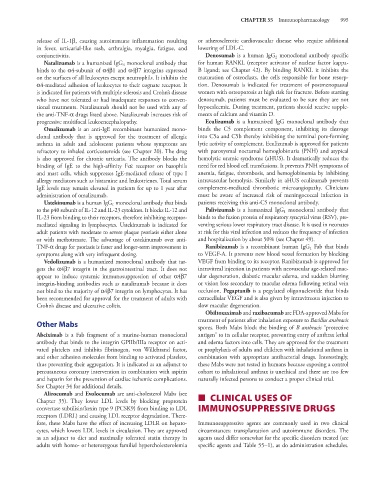Page 1009 - Basic _ Clinical Pharmacology ( PDFDrive )
P. 1009
CHAPTER 55 Immunopharmacology 995
release of IL-1β, causing autoimmune inflammation resulting or atherosclerotic cardiovascular disease who require additional
in fever, urticarial-like rash, arthralgia, myalgia, fatigue, and lowering of LDL-C.
conjunctivitis. Denosumab is a human IgG 2 monoclonal antibody specific
Natalizumab is a humanized IgG monoclonal antibody that for human RANKL (receptor activator of nuclear factor kappa-
4
binds to the α4-subunit of α4β1 and α4β7 integrins expressed B ligand; see Chapter 42). By binding RANKL it inhibits the
on the surfaces of all leukocytes except neutrophils. It inhibits the maturation of osteoclasts, the cells responsible for bone resorp-
α4-mediated adhesion of leukocytes to their cognate receptor. It tion. Denosumab is indicated for treatment of postmenopausal
is indicated for patients with multiple sclerosis and Crohn’s disease women with osteoporosis at high risk for fracture. Before starting
who have not tolerated or had inadequate responses to conven- denosumab, patients must be evaluated to be sure they are not
tional treatments. Natalizumab should not be used with any of hypocalcemic. During treatment, patients should receive supple-
the anti-TNF-α drugs listed above. Natalizumab increases risk of ments of calcium and vitamin D.
progressive multifocal leukoencephalopathy. Eculizumab is a humanized IgG monoclonal antibody that
Omalizumab is an anti-IgE recombinant humanized mono- binds the C5 complement component, inhibiting its cleavage
clonal antibody that is approved for the treatment of allergic into C5a and C5b thereby inhibiting the terminal pore-forming
asthma in adult and adolescent patients whose symptoms are lytic activity of complement. Eculizumab is approved for patients
refractory to inhaled corticosteroids (see Chapter 20). The drug with paroxysmal nocturnal hemoglobinuria (PNH) and atypical
is also approved for chronic urticaria. The antibody blocks the hemolytic uremic syndrome (aHUS). It dramatically reduces the
binding of IgE to the high-affinity Fcε receptor on basophils need for red blood cell transfusions. It prevents PNH symptoms of
and mast cells, which suppresses IgE-mediated release of type I anemia, fatigue, thrombosis, and hemoglobinemia by inhibiting
allergy mediators such as histamine and leukotrienes. Total serum intravascular hemolysis. Similarly in aHUS eculizumab prevents
IgE levels may remain elevated in patients for up to 1 year after complement-mediated thrombotic microangiopathy. Clinicians
administration of omalizumab. must be aware of increased risk of meningococcal infection in
Ustekinumab is a human IgG monoclonal antibody that binds patients receiving this anti-C5 monoclonal antibody.
1
to the p40 subunit of IL-12 and IL-23 cytokines. It blocks IL-12 and Palivizumab is a humanized IgG monoclonal antibody that
1
IL-23 from binding to their receptors, therefore inhibiting receptor- binds to the fusion protein of respiratory syncytial virus (RSV), pre-
mediated signaling in lymphocytes. Ustekinumab is indicated for venting serious lower respiratory tract disease. It is used in neonates
adult patients with moderate to severe plaque psoriasis either alone at risk for this viral infection and reduces the frequency of infection
or with methotrexate. The advantage of ustekinumab over anti- and hospitalization by about 50% (see Chapter 49).
TNF-α drugs for psoriasis is faster and longer-term improvement in Ranibizumab is a recombinant human IgG Fab that binds
1
symptoms along with very infrequent dosing. to VEGF-A. It prevents new blood vessel formation by blocking
Vedolizumab is a humanized monoclonal antibody that tar- VEGF from binding to its receptor. Ranibizumab is approved for
gets the α4β7 integrin in the gastrointestinal tract. It does not intravitreal injection in patients with neovascular age-related mac-
appear to induce systemic immunosuppression of other α4β7 ular degeneration, diabetic macular edema, and sudden blurring
integrin-binding antibodies such as natalizumab because it does or vision loss secondary to macular edema following retinal vein
not bind to the majority of α4β7 integrin on lymphocytes. It has occlusion. Pegaptanib is a pegylated oligonucleotide that binds
been recommended for approval for the treatment of adults with extracellular VEGF and is also given by intravitreous injection to
Crohn’s disease and ulcerative colitis. slow macular degeneration.
Obiltoxaximab and raxibacumab are FDA-approved Mabs for
Other Mabs treatment of patients after inhalation exposure to Bacillus anthracis
spores. Both Mabs block the binding of B anthracis “protective
Abciximab is a Fab fragment of a murine-human monoclonal antigen” to its cellular receptor, preventing entry of anthrax lethal
antibody that binds to the integrin GPIIb/IIIa receptor on acti- and edema factors into cells. They are approved for the treatment
vated platelets and inhibits fibrinogen, von Willebrand factor, or prophylaxis of adults and children with inhalational anthrax in
and other adhesion molecules from binding to activated platelets, combination with appropriate antibacterial drugs. Interestingly,
thus preventing their aggregation. It is indicated as an adjunct to these Mabs were not tested in humans because exposing a control
percutaneous coronary intervention in combination with aspirin cohort to inhalational anthrax is unethical and there are too few
and heparin for the prevention of cardiac ischemic complications. naturally infected persons to conduct a proper clinical trial.
See Chapter 34 for additional details.
Alirocumab and Evolocumab are anti-cholesterol Mabs (see
Chapter 35). They lower LDL levels by blocking proprotein ■ CLINICAL USES OF
convertase subtilisin/kexin type 9 (PCSK9) from binding to LDL IMMUNOSUPPRESSIVE DRUGS
receptors (LDRL) and causing LDL receptor degradation. There-
fore, these Mabs have the effect of increasing LDLR on hepato- Immunosuppressive agents are commonly used in two clinical
cytes, which lowers LDL levels in circulation. They are approved circumstances: transplantation and autoimmune disorders. The
as an adjunct to diet and maximally tolerated statin therapy in agents used differ somewhat for the specific disorders treated (see
adults with homo- or heterozygous familial hypercholesterolemia specific agents and Table 55–1), as do administration schedules.

